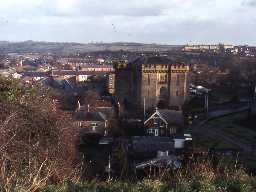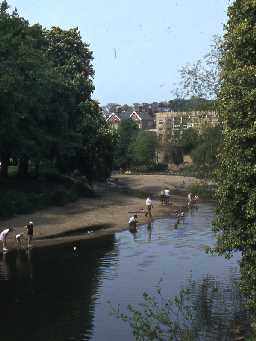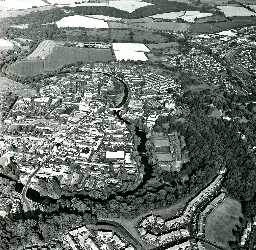Local History
Morpeth (Northumberland)

View over Morpeth rooftops. Photo by Harry Rowland, 1984.

River Wansbeck in Morpeth. Photo by Harry Rowland.

Morpeth town from the air. Copyright Tim Gates, 2003.
The historic town of Morpeth stands on the River Wansbeck in the south of Northumberland. Its position as a crossing-point over the river has meant that the area has long been occupied. However, there are few remains from prehistory. The earliest evidence of occupation in the area is a stone axe, which was probably of Neolithic date. Beyond this there is little hard evidence for early settlement. Aerial photographs of the area have shown the cropmarks of a number of rectangular enclosures at sites such as Highhouse Dean. These could be of either Iron Age or Roman date, but none have been excavated, so little is known about them. Any early remains nearer the river crossing have probably been destroyed by later building in the area.
Although close to Hadrian's Wall, the northern frontier of Roman Britain for much of the period of Roman rule, there are few remains from this period. Only one object of Roman date has been found, a small copper alloy object shaped like a button and loop, which was probably part of a set of horse harness. Despite this relative lack of evidence, it is likely that there were settlements of Romano-British date in the area. The rectangular cropmarks mentioned above are similar to settlements of known first to fourth century AD date found elsewhere in Northumberland. However, none of these have been excavated so their date remains uncertain. It also likely that some people would have lived in the town close to the river, where the river crossing would have been an important strategic site.
It was the importance of this river crossing that led the construction of a Norman motte and bailey castle on Haw Hill, just to the south of the town. It had been built by 1095, and shows the importance the new Norman kings placed on securing control of the area. Although beginning as a simple wooden structure, this was replaced by a stone building on the same site. However, King John burnt this down in the early 13th century, and a new better-defended stone castle was built on the adjacent hill.
Although the town of Morpeth grew up on the north side of the Wansbeck, the most important medieval buildings were built to the south of the river. The Church of St Mary was built to the south of the castle. Although, the earliest surviving remains of the church belong to the 13th and 14th centuries, it is likely that there may have been an earlier structure at the site. The church contains some of the most important stained glass in Northumberland. Further along the river was the important Cistercian monastery of Newminster, which held land over much of Northumberland and beyond. Monks from the important monastery at Fountains in Yorkshire founded it in 1198. Although the site is largely in ruins parts of the cloister can still be seen. The church and the abbey were not the only religious buildings in medieval Morpeth. A small chantry stands near the bridge. It was built in the 13th century, but by the early 14th century it was being used as a school. A number of crosses also marked the boundaries of the early borough of Morpeth. One stood at Bowles Cross and another at Stob Cross.
Much of the plan of the modern town centre probably dates back to the medieval period, and many roads, such as Oldgate, Hillgate and Bridge Street, are recorded on historical documents from the 13th or 14th century. The town was given permission to hold a market in 1200. It probably took place on the site of the modern market place. The market was also especially important for the buying and selling of cattle, and by the mid-18th century it was one of the most important cattle markets in the country. It only began to decline in importance with the building of the railways in the mid-19th century.
Before the medieval period the River Wansbeck had probably only been crossed by a ford. However, with the growing importance of the market a new stone bridge was built, probably in the 13th century. Although the bridge was partly demolished in the 19th century, it is still possible to see the remains of this earlier bridge just to the west of the modern bridge. A small footbridge now uses the surviving stone bases for support. A new bridge was built in the 1830s by the famous engineer Thomas Telford, just downstream of the old bridge. Traffic had to pay money at the nearby tollhouse to cross this bridge. Another medieval stone bridge was probably also built close to Newminster Abbey, though no remains of this survive to be seen. As well as these bridges there were sets of stepping-stones at Bullers-Green, Oldgate and near the old Bakehouse.
In the 18th and 19th century Morpeth was a thriving market town. The noted architect Sir John Vanbrugh designed the town hall, though the building was rebuilt in 1869 after a fire. Close to the town hall stands the Clock Tower, one of Morpeth's best-known landmarks. Although it contains fragments of medieval carved stone, it was not built until the late 17th or early 18th century. The stone was probably taken from the site of Newminster Abbey. At the other end of town a prison and courthouse were built in the 19th century; the massive gatehouse is still visible today.
Although the town was a centre of trade for the surrounding countryside, the citizens of Morpeth enjoyed their leisure hours. In 1730 they built a racecourse for horse racing. It was still in use in the mid-19th century. It only fell out of use when the asylum was built. The area around the two castles became a park in the late 19th century, and the people were able to follow riverside walks along the Wansbeck.
In the later 19th century life in Morpeth changed. As the railway, with its station and viaduct, was built Morpeth's role as a market decline. It was easier for people to take their goods straight to Newcastle. To the south and east mining became increasingly important and the central role of agriculture declined. Morpeth always remained on the edge of the mining areas, though small areas of mining did take place in the parish.
Although small, several famous people came from Morpeth. The great sailor Admiral Lord Collingwood, who was Admiral Nelson's second-in-command at the Battle of Trafalgar, came from Morpeth. He lived in Collingwood House, which is now marked by a plaque. A more controversial figure was Emily Davison, who campaigned for women to get the vote in the early 20th century. She was killed at the Epsom Derby in 1913 when she ran in front of the king's racehorse. She was buried in Morpeth, and her {gravestone N11186} can still be seen.
Morpeth survived World War II relatively unscathed, though several pillboxes were built to defend the river crossing and the main road north. The closest the war came was when a Heinkel 111, a German bomber, crashed close to Howburn Wood.
The town is now the county town of Northumberland, and local government is one of the biggest employers in the area. The area also attracts tourists and boasts England's only bagpipe museum!
Although close to Hadrian's Wall, the northern frontier of Roman Britain for much of the period of Roman rule, there are few remains from this period. Only one object of Roman date has been found, a small copper alloy object shaped like a button and loop, which was probably part of a set of horse harness. Despite this relative lack of evidence, it is likely that there were settlements of Romano-British date in the area. The rectangular cropmarks mentioned above are similar to settlements of known first to fourth century AD date found elsewhere in Northumberland. However, none of these have been excavated so their date remains uncertain. It also likely that some people would have lived in the town close to the river, where the river crossing would have been an important strategic site.
It was the importance of this river crossing that led the construction of a Norman motte and bailey castle on Haw Hill, just to the south of the town. It had been built by 1095, and shows the importance the new Norman kings placed on securing control of the area. Although beginning as a simple wooden structure, this was replaced by a stone building on the same site. However, King John burnt this down in the early 13th century, and a new better-defended stone castle was built on the adjacent hill.
Although the town of Morpeth grew up on the north side of the Wansbeck, the most important medieval buildings were built to the south of the river. The Church of St Mary was built to the south of the castle. Although, the earliest surviving remains of the church belong to the 13th and 14th centuries, it is likely that there may have been an earlier structure at the site. The church contains some of the most important stained glass in Northumberland. Further along the river was the important Cistercian monastery of Newminster, which held land over much of Northumberland and beyond. Monks from the important monastery at Fountains in Yorkshire founded it in 1198. Although the site is largely in ruins parts of the cloister can still be seen. The church and the abbey were not the only religious buildings in medieval Morpeth. A small chantry stands near the bridge. It was built in the 13th century, but by the early 14th century it was being used as a school. A number of crosses also marked the boundaries of the early borough of Morpeth. One stood at Bowles Cross and another at Stob Cross.
Much of the plan of the modern town centre probably dates back to the medieval period, and many roads, such as Oldgate, Hillgate and Bridge Street, are recorded on historical documents from the 13th or 14th century. The town was given permission to hold a market in 1200. It probably took place on the site of the modern market place. The market was also especially important for the buying and selling of cattle, and by the mid-18th century it was one of the most important cattle markets in the country. It only began to decline in importance with the building of the railways in the mid-19th century.
Before the medieval period the River Wansbeck had probably only been crossed by a ford. However, with the growing importance of the market a new stone bridge was built, probably in the 13th century. Although the bridge was partly demolished in the 19th century, it is still possible to see the remains of this earlier bridge just to the west of the modern bridge. A small footbridge now uses the surviving stone bases for support. A new bridge was built in the 1830s by the famous engineer Thomas Telford, just downstream of the old bridge. Traffic had to pay money at the nearby tollhouse to cross this bridge. Another medieval stone bridge was probably also built close to Newminster Abbey, though no remains of this survive to be seen. As well as these bridges there were sets of stepping-stones at Bullers-Green, Oldgate and near the old Bakehouse.
In the 18th and 19th century Morpeth was a thriving market town. The noted architect Sir John Vanbrugh designed the town hall, though the building was rebuilt in 1869 after a fire. Close to the town hall stands the Clock Tower, one of Morpeth's best-known landmarks. Although it contains fragments of medieval carved stone, it was not built until the late 17th or early 18th century. The stone was probably taken from the site of Newminster Abbey. At the other end of town a prison and courthouse were built in the 19th century; the massive gatehouse is still visible today.
Although the town was a centre of trade for the surrounding countryside, the citizens of Morpeth enjoyed their leisure hours. In 1730 they built a racecourse for horse racing. It was still in use in the mid-19th century. It only fell out of use when the asylum was built. The area around the two castles became a park in the late 19th century, and the people were able to follow riverside walks along the Wansbeck.
In the later 19th century life in Morpeth changed. As the railway, with its station and viaduct, was built Morpeth's role as a market decline. It was easier for people to take their goods straight to Newcastle. To the south and east mining became increasingly important and the central role of agriculture declined. Morpeth always remained on the edge of the mining areas, though small areas of mining did take place in the parish.
Although small, several famous people came from Morpeth. The great sailor Admiral Lord Collingwood, who was Admiral Nelson's second-in-command at the Battle of Trafalgar, came from Morpeth. He lived in Collingwood House, which is now marked by a plaque. A more controversial figure was Emily Davison, who campaigned for women to get the vote in the early 20th century. She was killed at the Epsom Derby in 1913 when she ran in front of the king's racehorse. She was buried in Morpeth, and her {gravestone N11186} can still be seen.
Morpeth survived World War II relatively unscathed, though several pillboxes were built to defend the river crossing and the main road north. The closest the war came was when a Heinkel 111, a German bomber, crashed close to Howburn Wood.
The town is now the county town of Northumberland, and local government is one of the biggest employers in the area. The area also attracts tourists and boasts England's only bagpipe museum!
N13457
UNCERTAIN
Disclaimer -
Please note that this information has been compiled from a number of different sources. Durham County Council and Northumberland County Council can accept no responsibility for any inaccuracy contained therein. If you wish to use/copy any of the images, please ensure that you read the Copyright information provided.